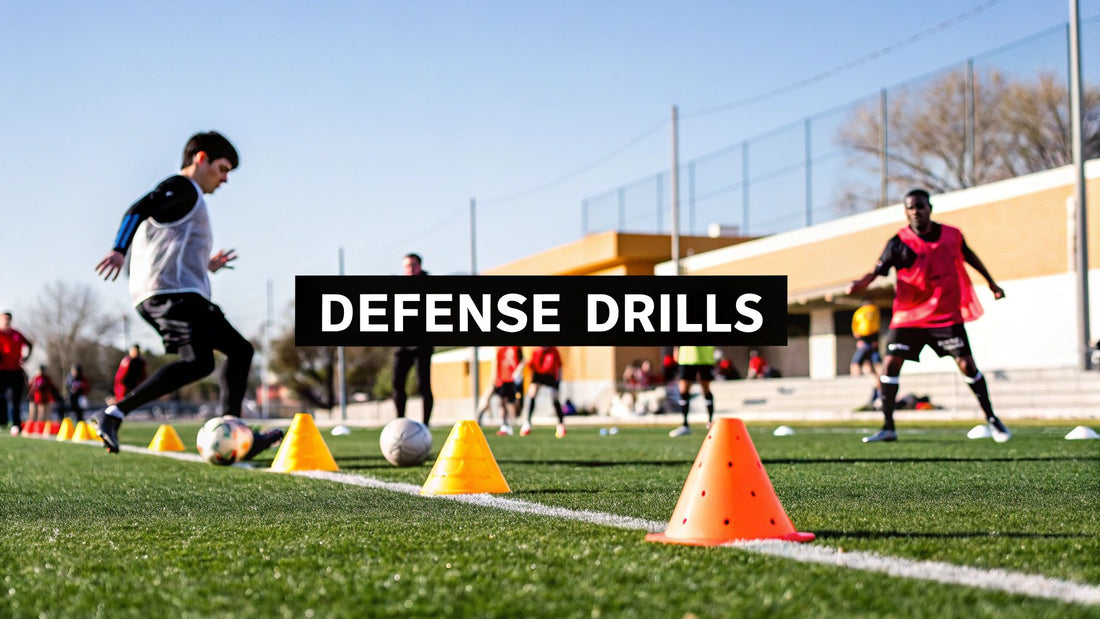Great soccer drills for defence are about more than just individual tackling. They’re about forging an organised, communicative, and proactive unit that gives the whole team the confidence to attack, knowing the backline is locked down. This is your blueprint for defensive excellence.
Building a Fortress with Modern Defensive Principles
Let's be real—a leaky defence sinks seasons. A rock-solid backline is built on intelligent organisation, seamless communication, and proactive positioning, not just last-ditch tackles. Modern defending is about snuffing out scoring chances long before a shot is even taken.
This guide maps out the drills that will help you forge an impenetrable unit. We'll start with mastering fundamental 1v1 duels and build all the way up to coordinating the entire team's press. Each exercise layers on the last, creating a robust and intelligent defensive system. It's not just about stopping goals; it's about building a foundation of stability from the back.
For more on this, you can also check out our other guide on drills for soccer defenders.
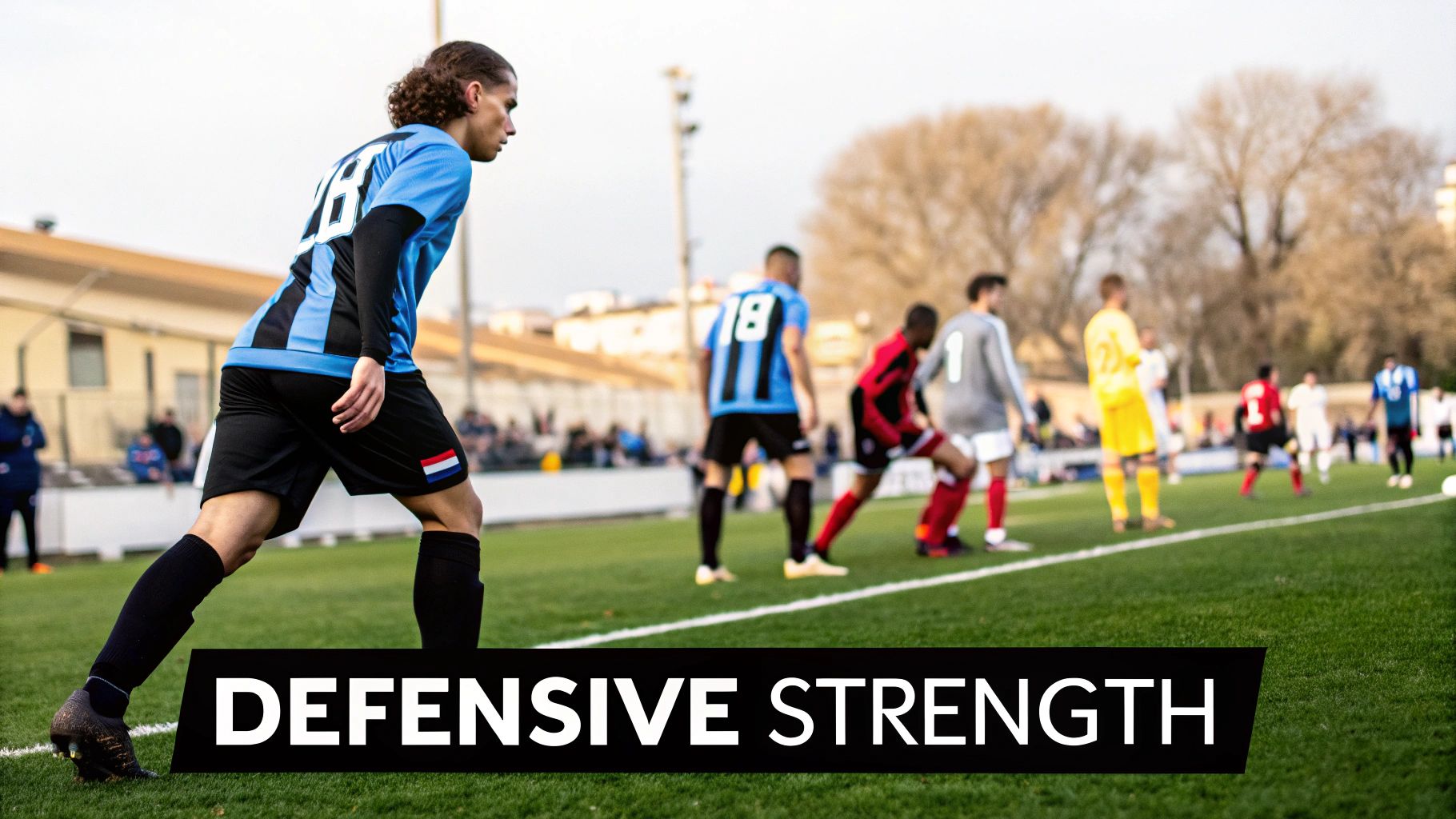
Core Philosophies of Modern Defending
Before jumping into the drills, it’s crucial to understand the principles that make them work. A modern defence operates as a single, connected entity, not just a collection of individuals. This collective mindset is what separates a good defence from a great one.
Here are the key ideas we'll be focusing on:
- Pressure, Cover, and Balance: This is the holy trinity of defending. The first defender pressures the ball carrier, the next provides cover, and the rest of the unit stays balanced to guard against a switch of play.
- Compactness: It’s all about minimising space. A compact shape, both horizontally and vertically, makes it incredibly difficult for opponents to play through the lines.
- Proactive Positioning: The best defenders read the game. They anticipate play and position themselves to intercept passes or block shooting lanes, rather than just reacting after the ball is played.
A strong defence gives you the best chance of winning the game. It is the platform for everything else. When your team knows the back is secure, every player feels more confident to express themselves offensively.
The Impact of a Drilled Defence
History proves it time and again: championship-winning teams are almost always built on defensive solidity.
Just look at Chelsea’s 2004-05 title-winning season under Jose Mourinho in the Premier League. They set a record for clean sheets with an incredible 25, a testament to their organisation. That wasn't an accident. Their dominance came from intensive training focused on zonal marking, tactical compactness, and rapid counter-pressing. You can read more about the Premier League's best defensive records over on OneFootball.com.
Overview of Key Defensive Drill Categories
To help you navigate the drills in this guide, we've broken them down into categories. This table gives you a quick summary of what each type of drill focuses on, so you can pick the right exercises for your team's specific needs.
| Drill Category | Primary Focus | Key Player Skills |
|---|---|---|
| 1v1 Defending | Mastering individual duels and body positioning. | Jockeying, tackling, forcing attackers wide. |
| Small-Sided Scenarios | Developing communication and decision-making in units (2v2, 3v2). | Pressure/cover balance, intercepting passes. |
| Zonal Defending & Shape | Maintaining a compact and organised defensive block. | Shifting as a unit, passing on runners. |
| Pressing & Counter-Pressing | Winning the ball back quickly and high up the pitch. | Triggers for pressing, closing down space. |
| Defending Crosses & Set Pieces | Organisation in the box and aerial dominance. | Marking, heading, and controlling the area. |
Each category builds upon the last, taking your players from individual masters to a cohesive, impenetrable unit. Ready to get started? Let's dive in.
Mastering the Art of 1v1 Dominance
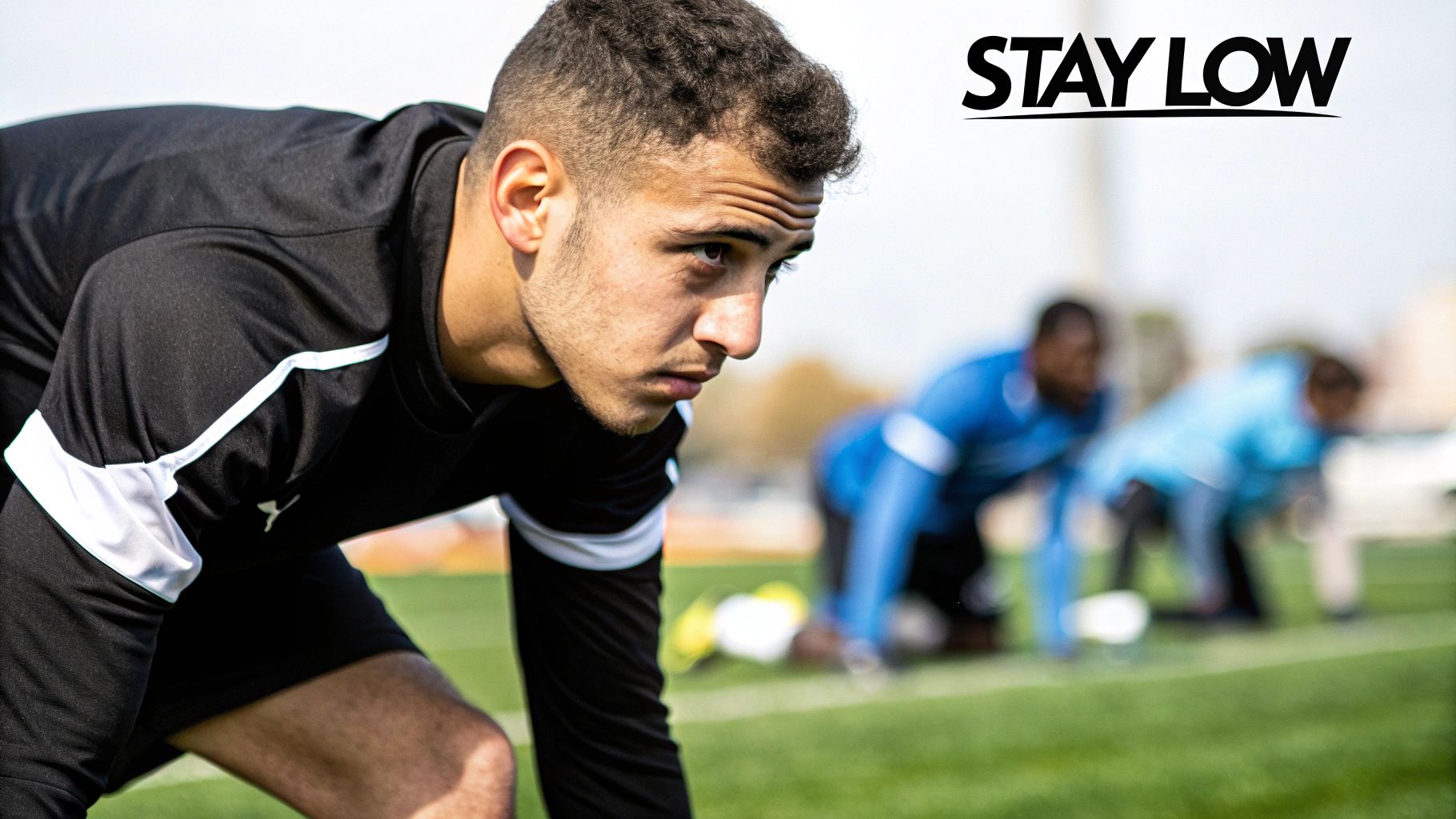
Every great defence is built on one simple truth: players must win their individual battles. When a defender consistently shuts down their opponent one-on-one, it completely kills an attack's rhythm and gives your team a massive psychological edge. This is where real defensive confidence is born.
But 1v1 defending isn't all about flying into slide tackles. It's a craft. It’s about nailing your stance, dictating where the attacker goes, and knowing the perfect moment to step in. These are the skills that separate good defenders from great ones.
Perfecting the Jockeying Stance
First things first, we need to strip it back to the absolute foundation: body position and movement. This drill is all about learning to jockey an attacker, pushing them into less dangerous areas without diving in and getting beaten.
Drill Setup:
- Set up a 15x15 yard grid with cones.
- One attacker starts with a ball at one end. A defender starts five yards away, facing them.
- The attacker’s goal is simple: dribble across the grid to the opposite end line.
- The defender's job? Stop them using only body position and movement. No tackling is allowed.
The defender needs to get into a low, side-on stance, staying light on the balls of their feet. This body shape is crucial for quick changes of direction. The idea is to show the attacker the outside line, forcing them away from the centre of the pitch where the real danger is.
Adding Pressure with the 'Channel' Drill
Once players are comfortable with the basic jockeying movement, it's time to ramp up the pressure. The 'Channel' drill forces defenders to make quick decisions and funnels attackers into tight, predictable spaces. This is honestly one of the most effective soccer drills for defence you can run for individual skill.
You just need to set up a long, narrow channel (around 20 yards long and 5 yards wide) with cones. The attacker dribbles from one end, and the defender has to stay between them and the "goal" (the far end line), aiming to win the ball or force it out of play.
The secret here is to close the attacker down quickly, but then slow your feet as you get close. This is often called 'arcing your run'. If you just sprint in a straight line, a good attacker will knock the ball past you every single time.
You can see the impact of this skill at the very top level. In a recent Premier League season, centre-backs like Nottingham Forest’s Willy Boly were masters of winning their duels. Boly actually had the highest success rate in defensive duels at an incredible 83.33%. That kind of number comes from countless hours spent perfecting tackle timing and spatial awareness.
Progressing to a Live Goal Scenario
The final step is to put everything together in a situation that feels like a real match. Set up a goal with a keeper and create a grid about 25 yards out. The attacker receives a pass and their only aim is to score, while the defender has to use all the skills they've just practised—jockeying, timing, and now, tackling.
This adds the critical element of protecting the goal, making every decision and every movement count. For a closer look at how to build out your training sessions, you might find our guide on designing effective defence soccer drills useful.
Forging Unbreakable Defensive Partnerships
Individual defensive skill is the foundation, but let's be honest, great defending is all about partnerships. It’s that almost telepathic link between two centre-backs or a full-back and a winger that turns a solid defence into an unbreakable one. This is where your focus has to shift from 1v1 duels to small-group cohesion in your soccer drills for defence.
The goal here is simple: coach players to cover for each other, communicate without thinking, and move like a single, coordinated unit. It's about building on-pitch relationships where a quick glance or a pointed finger says more than a full sentence ever could.
These drills aren't just about running around. They force defenders into making split-second decisions together: who steps up to pressure the ball, who drops to provide cover, and how do they hold a shape that kills the attack before it even starts?
The Classic 2v2 to a Goal
Let's start with a situation you'll see a dozen times in any given match. The 2v2 drill is the ultimate test of that partnership—it exposes weaknesses in communication, decision-making, and trust almost instantly. It’s dead simple to set up but incredibly revealing.
Drill Setup:
- You'll need one full-sized goal with a keeper.
- Mark out a playing area roughly 30 yards long and 25 yards wide.
- Two attackers kick things off near the halfway line, with two defenders positioned just outside the penalty area.
- The coach starts the drill by playing a ball into the attackers, who then go live and try to score.
The entire drill is built on one core principle: pressure and cover. One defender has to get tight on the ball carrier immediately, shutting down any chance of a shot or a defence-splitting pass. While that's happening, the second defender must drop a few yards, providing cover and reading the play, ready for the next move.
The single biggest mistake defenders make in this scenario is getting "flat"—standing on the same horizontal line. The covering defender absolutely must be deeper and narrower, in a position to intercept a pass or challenge the second attacker if the ball gets played across.
Progressing to the 3v2 Overload
Once your pairs are communicating well and look comfortable in the 2v2, it's time to ramp up the pressure. The 3v2 overload simulates one of the most dangerous situations in football: the dreaded counter-attack. This drill forces your two defenders to think on their feet, communicate non-stop, and make smart choices when they're outnumbered.
The setup is pretty much the same as the 2v2, but you simply add a third attacker. This immediately presents a problem that the defenders have to solve together. They can't just go man-for-man anymore; they have to prioritise the biggest threats.
Key Coaching Points:
- Force Play Wide: The number one job here is to stop the attackers from getting a clean shot from a central position. Defenders need to work in tandem to show the attackers into the wide areas, where the angle is tighter and the danger is lower.
- Delay the Attack: When you're outnumbered, sometimes the best you can do is buy time. The goal is often to simply slow the attack down long enough for your midfielders to track back and help out. This isn't about diving into tackles; it's about smart jockeying and patience.
- Constant Communication: The defenders have to be loud. "I've got ball!" "Cover inside!" "Watch the runner!" This constant stream of information, both verbal and non-verbal, is what allows them to manage the overload without getting pulled apart.
By mastering these partnership drills, players learn to trust and rely on each other. You start to see individual talents merge into a formidable defensive unit that is far, far greater than the sum of its parts.
Organising Your Backline Like the Pros
Right, let’s move beyond individual battles and small-sided games. It's time to scale up and get the entire defensive line working as one. This is where you turn a group of four defenders into a proper back four—not just four individuals happening to stand near each other.
Genuine defensive solidity isn’t about winning a single tackle; it comes from collective movement, organisation, and a shared understanding of space. These drills are designed to hammer home that discipline, teaching your backline to maintain its shape, press together, and shift as a single entity to squeeze the life out of an attack.
The Famous Pendulum Drill
If there's one drill every defensive coach loves, it's the 'Pendulum Drill'. Its beauty is in its simplicity, yet it’s incredibly effective for teaching a backline how to slide across the pitch in response to the ball. The main goal here? Maintain a compact shape and consistent spacing between defenders at all times.
Drill Setup:
- Get your back four (or five) set up across the width of the penalty area.
- Position two coaches (or spare players) about 30 yards out from goal, one on the left and one on the right, each with a good supply of balls.
- The coaches simply pass the ball back and forth between each other, forcing the defensive line to shift from side to side like a pendulum. Simple, right?
As the ball travels, the entire unit has to move. The full-back on the ball side steps up to apply "pressure," while the other three defenders shuffle across and tuck in to provide cover and keep the shape balanced. The absolute key is keeping the distances between each defender consistent. You can't let gaps open up for runners to exploit.
This image below perfectly visualises how a defensive unit should assign zones, shift with the ball, and collectively close down dangerous areas.
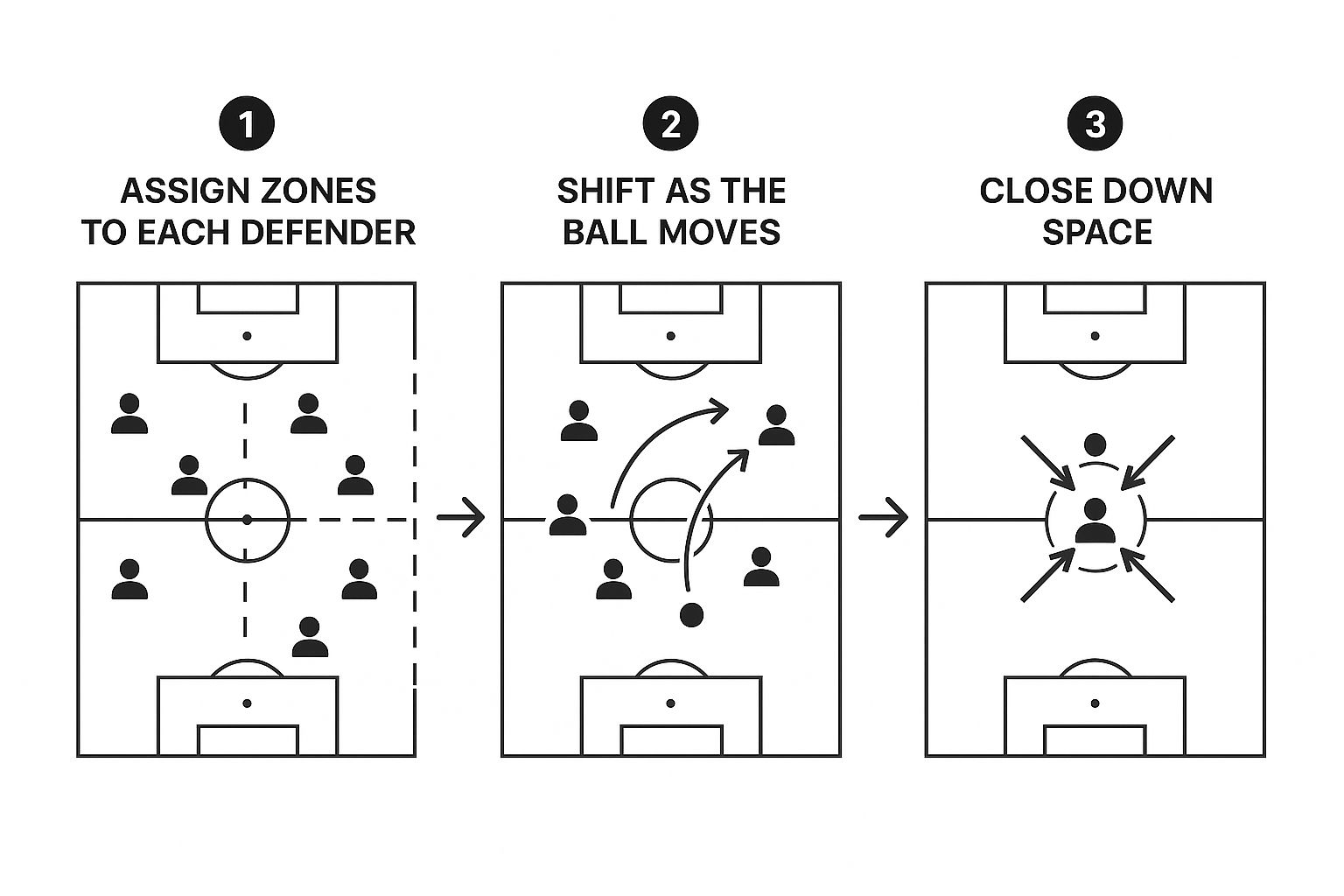
You can see how individual responsibility and collective movement are totally intertwined. Get it right, and there are simply no gaps for attackers to play through.
Defending Crosses and Eliminating Chaos
Few things cause more panic in a defence than a well-whipped cross into the box. This drill is all about getting rid of that chaos by assigning clear roles and responsibilities. When the ball comes in from out wide, every player needs to know their job without a second thought.
Set up your back four defending the goal against two strikers in the penalty area and two wingers positioned out wide. The coach starts by playing the ball out to one of the wingers, who then delivers a cross. It's on the defenders to work together to mark the strikers, attack the ball, and clear the danger decisively.
The nearest full-back has to get out and pressure the winger to stop or delay the cross. Meanwhile, the centre-backs must get organised, marking the runners and communicating loudly. Shouts of "Man on!" or "Keeper's ball!" are non-negotiable here; they’re what prevent confusion and cheap goals.
The first defender's pressure dictates everything. If the full-back can delay the cross, it gives the rest of the unit a crucial extra second to get organised and into their defensive positions.
Backline Drill Progression Plan
Building a rock-solid backline doesn't happen overnight. It's about layering principles week by week. You start with the basics of shape and movement, then gradually introduce more complex, game-like scenarios.
Here is a sample weekly progression plan that shows how you can build up your defensive unit's understanding and execution.
| Day | Focus | Example Drill | Key Objective |
|---|---|---|---|
| Mon | Basic Shape & Spacing | Pendulum Drill | Maintain a compact shape and consistent gaps. |
| Tues | Pressing Triggers | 4v2 Pressing Game | Recognise when to press and when to drop as a unit. |
| Wed | Defending Crosses | Wide Area Overloads | Assign roles for marking, challenging, and covering. |
| Thurs | Dealing with Through Balls | Drop & Cover Drill | Master the offside trap and recovery runs. |
| Fri | Game Scenarios & Communication | 8v8 Conditioned Game | Apply all learned principles under match pressure. |
By following a structured plan like this, players internalise their roles, and the backline starts to operate on instinct rather than hesitation.
Adding Realism to Your Drills
To really sharpen spatial awareness and decision-making, you need to simulate match conditions as closely as possible. Using gear like the training poles and mannequins from SoccerWares can represent opposing forwards. This forces your defenders to adjust their positioning around realistic obstacles instead of just empty space. It makes a huge difference.
The impact of this kind of organised, repetitive drilling can't be overstated. Just look at Burnley's incredible Championship season, where they built their success on a stunning defensive record, keeping 22 clean sheets in their first 31 games. According to a breakdown from The Analyst, this remarkable solidity was forged on the training ground with rigorous drills focused on positioning, communication, and coordinated pressing.
By focusing on the entire unit, you don't just coach defenders—you build a backline that is genuinely tough to break down.
Turning Your Entire Team into a Defensive Force
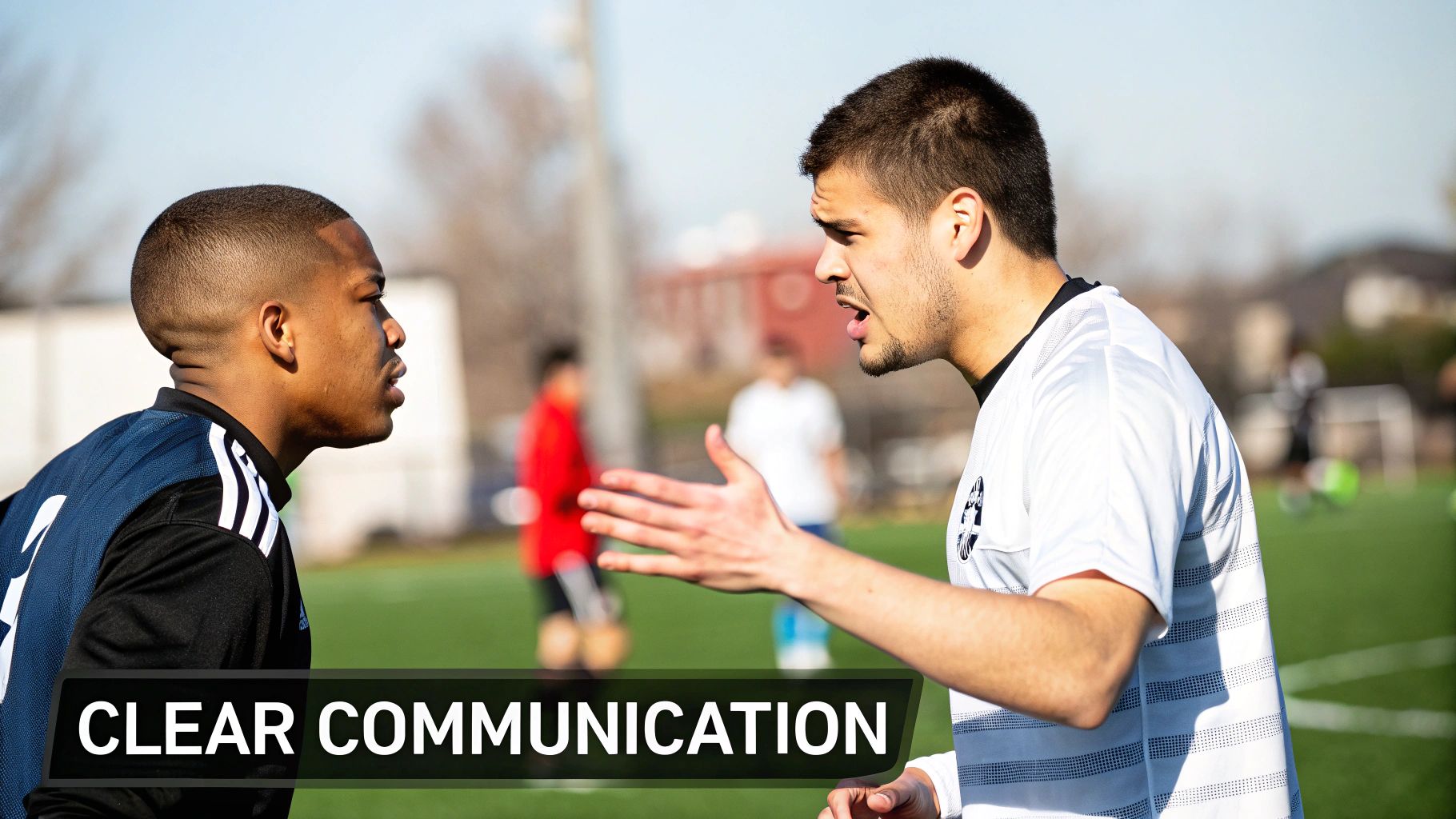
Elite defending isn't just about what your back four does. It’s a collective mindset that starts right from the top of the pitch. When your whole team buys into the idea that winning the ball back is everyone's job, you create a defensive machine.
The hard graft put in by your attackers and midfielders makes life so much easier for the defenders behind them. A forward who presses intelligently or a midfielder who screens a pass can completely stifle an opponent's build-up. It forces them into playing long, hopeful balls instead of controlled, dangerous attacks. That's the essence of defending as a unit.
Instilling the High Press
A high press can be a devastating weapon, but it has to be organised. A chaotic press is often worse than no press at all, as it just leaves massive gaps for the other team to play through. The secret is teaching your forwards when to go and what the triggers are.
Some of the most common pressing triggers we coach are:
- A poor first touch: The moment an opponent takes a heavy touch, it's the green light for your nearest player to close them down hard.
- A backwards pass: When the ball goes back towards their own goal, the opposition is vulnerable. This is a perfect signal for your entire front line to squeeze up and apply pressure.
- A player receiving the ball facing their own goal: This is a golden opportunity. The player is blind to the pressure coming from behind them, making them an easy target.
The goal of a press isn't always to win the ball back instantly. A lot of the time, it's about forcing a rushed, predictable pass that your midfielders can hoover up. It’s about dictating where the opposition can—and more importantly, cannot—play.
Defending in Compact Blocks
What happens when the initial press is beaten? Your team needs to snap back into a compact, organised shape. This means midfielders getting goal-side to shield the defence and forwards dropping in to block passing lanes. The aim is to make it almost impossible for the opposition to play through the middle.
A great way to coach this is with a simple "Shadow Play" drill. Have your midfield and forward lines shift together as coaches pass a ball around them. You're looking for them to maintain tight distances between each other, both vertically and horizontally. This discipline forces the attacking team out into the wide, less dangerous areas of the pitch.
A rock-solid defence is built on every single player understanding their role. For a deeper look at specific training exercises, check out our comprehensive guide covering more soccer drills for defense. By embedding these principles, you’ll build a balanced team that’s as formidable without the ball as they are with it. This defensive unity is the true foundation for success.
Got Questions About Your Defensive Drills?
Even with the best plan, questions always pop up on the training ground. Getting your defence organised is a process, and figuring out the kinks is just part of coaching. Here, we'll tackle some of the most common questions I hear from coaches and players when they start putting new soccer drills for defence into practice.
Getting these details right can be the difference between a defence that looks good in training and one that actually holds up under pressure on match day. Think of it as fine-tuning your defensive engine.
How Often Should My Team Practise Defensive Drills?
Consistency is everything. You should be weaving defensive work into every single training session, even if it's just for a few minutes. It doesn't always have to be a full-blown, hour-long session on tactical shape.
A great way to structure it is to dedicate 20-30 minutes of one session per week purely to your team's defensive shape and organisation. For your other sessions, sprinkle in individual or small-group drills like 1v1s or 2v2s as part of your warm-ups. This keeps the core principles fresh in everyone's minds.
For younger teams, the focus should be squarely on 1v1 fundamentals. For senior teams, it's all about unit cohesion and communication. The goal is to make solid defensive habits completely second nature.
What Is The Most Important Quality for a Modern Defender?
Pace and strength are brilliant assets to have, no doubt. But the single most crucial quality for a modern defender is game intelligence. This isn't just one thing; it's an umbrella term that covers anticipation, reading the flow of the match, making smart positioning choices, and communicating with teammates.
A defender who reads the danger and gets into position early is far more effective than one who has to constantly rely on last-ditch recovery tackles. The drills in this guide are designed to build that football IQ, not just sharpen physical reactions.
Why Do My Players Nail the Drills but Struggle in Matches?
This is a classic coaching headache, and one I've faced many times. The solution is to make your training sessions feel more like the beautiful chaos of a real match. The key is to always progress your drills.
- Start unopposed. This is where you teach the basic movement patterns and responsibilities.
- Add passive opponents. Introduce attackers who offer light resistance but don't go full tilt. This helps players apply the principles against moving targets.
- Go fully live. Finally, run the drill in a situation where attackers are genuinely trying to score.
To really bridge that gap between the training ground and a real game, you need to add consequences and competition. Keep score, have the losing team collect the cones, whatever it takes to raise the stakes. This approach closes the gap between the calm, organised world of a drill and the high-pressure reality of match day.
How Can I Adapt These Drills for Different Formations?
The beauty of these defensive principles—pressure, cover, balance, and compactness—is that they're universal. They apply whether you're playing a 4-4-2, a 3-5-2, or any other setup you can think of. The adaptation is all in the setup details.
For instance, if you play with a back four, drills focusing on the 'pendulum' shift (where the backline shuffles across as a unit) are vital. If you use three centre-backs, you’ll need specific drills that teach the wide centre-backs how to cover the space behind attacking wing-backs.
Always start with the principle you want to teach, then simply adjust the number of players and their starting positions on the pitch to mirror your team's tactical shape.
Ready to gear up for success? At SoccerWares, we provide the high-quality training equipment you need to turn these drills into defensive dominance. From cones and markers to goals and rebounders, we've got you covered. Explore our full collection and elevate your training.

